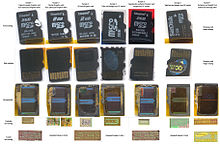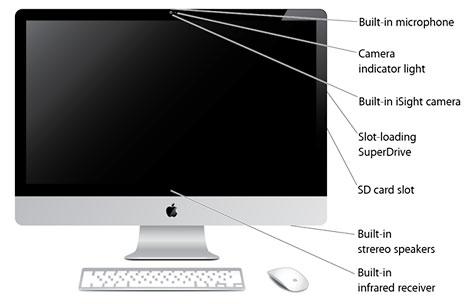Secure Digital Slot
An “SDXC card slot” is a slot in a computer that can read from and write to Secure Digital eXtended Capacity (SDXC) 1 memory cards. It will also be backwards-compatible with cards following the older standards SDHC (Secure Digital High Capacity). In later years, the mini’s Secure Digital slot was upgraded to support extended capacity SDXC cards up to 1 Terabyte of storage. Mac Mini SD Slot Location Apple is still including an SDXC (and SDHC - SD backward compatible) flash memory card slot on the slimmer aluminum Mac mini systems.
There are three main types in the SD memory card family. SD, SD High Capacity (SDHC™), and SD Extended Capacity (SDXC™). This article details the different specifications of all three types of SD memory cards and the speed class ratings and compatibilities that are different with each type.
Additional Reference: SD Assocation Consumer Information

SD capacities range from 128MB to 2GB
Default Format: FAT16
SD cards will work in all host devices that support SD, SDHC, or SDXC
SD High Capacity (SDHC™) card is an SD™ memory card based on the SDA 2.0 specification.
SDHC capacities range from 4GB to 32GB
Default Format: FAT32
Because SDHC works differently than standard SD cards, this format is NOT backwards compatible with host devices that only take SD (128MB - 2GB) cards. Most readers and host devices built after 2008 should be SDHC compatible.
To ensure compatibility, look for the SDHC logo on cards and host devices (cameras, camcorders, etc.)
SD Extended Capacity (SDXC™) card is an SD™ memory card based on the SDA 3.0 specification.
SDXC capacities range from 64GB to 2TB
Default Format: exFAT
Because SDXC uses a different file system called exFAT and it works differently than standard SD cards, this format is NOT backwards compatible with host devices that only take SD (128MB to 2GB) or host devices that only take SDHC (4GB to 32GB). Most host devices built after 2010 should be SDXC compatible.
To ensure compatibility, look for the SDXC logo on cards and host devices (cameras, camcorders, etc.).


NOTE: Internal card readers on laptops up to year 2008 may NOT support SDXC cards. SDXC cards will work in SDHC compatible readers (not SD readers) if the computer OS supports exFAT.
For more information on exFat see: Operating Systems that support the exFAT File System
Ultra High Speed, Phase I (UHS-I) bus design for SDHC and SDXC cards was added in SD spec 3.0. This is a design enhancement to increase the performance of SDHC/SDXC cards.
UHS-I specification defines two bus architecture options for up to 50MB/s (UHS-50) and 104MB/s (UHS-104) data transfer rates. These are theoretical maximum limits and actual maximum performance for a specific card is defined on it label or in advertising.
UHS is an enhancement to the original SD interface specifications. Host devices will obtain the UHS maximum speed when both the card and host device support UHS. Otherwise, the host device and card will use the slower SD maximum speed obtainable.
There is no compatibility problem using a UHS card with a non-UHS device.
Ultra High Speed Phase II (UHS-II) bus design for SDHC and SDXC was added in SD spec 4.0. This is an additional design enhacement with connector interface modifications to increase performance.
UHS-II specification defines bus architecture for options of 156MB/s and 312MB/s. Manufacturers implemented the 312MB/s option in memory cards. These are theoretical maximum limits and actual maximum performance for a specific card is defined on the label or in advertising.
Host devices will obtain the maximum UHS-II speed when both the card and the host device support UHS-II. Otherwise, the host device and card will use the highest compatible UHS-I or SD bus speed.
There is no compatibility problem using a USH-II card in a UHS-I or non-UHS device.

Speed Class & UHS Speed Class Rating
Speed class ratings define a minimum guaranteed speed of SDHC/SDXC cards. Speed class rating is important for HD video mode or camcorders, where the device is actually saving a steady stream of data. The resolution and format of the video determines the amount of steady stream data. You should consult your camera user manual for minimum speed class requirements for HD video modes.
Speed Class (SD Bus)
Class | Minimum Speed |
2 | 2MB/s |
4 | 4MB/s |
6 | 6MB/s |
8 | 8MB/s |
10 | 10MB/s |
UHS Speed Class (UHS Bus)
UHS Class | Minimum Speed |
1 | 10MB/s |
3 | 30MB/s |
For a more detailed explanation of speed class see: Difference between Speed Class, UHS Speed Class, and Speed Ratings...
SD Association: Speed Choices
Compatibility Summary
The chart below shows the host device and the memory cards supported.
| Host device (ex. cameras, video recorders, phones, readers, etc.) | Memory cards supported |

- SDXC memory cards can ONLY be used with SDXC host devices.
- SDXC memory cards will NOT work with SD / SDHC host devices.
Additional info on SDXC cards and host devices
- SDXC host devices can use and support SD, SDHC and SDXC memory cards.
- SDHC host devices can use and support both SD and SDHC memory cards.
- SDHC memory cards can be used with SDHC and SDXC host devices.
Companies need to have documents signed at all times in order to do business properly. Business contracts, purchase, sale, partnership, service offers, confidentiality agreements, etc. These documents are essential and are the cornerstones of the business world.
In recent years, many companies have begun the digital shift within their organizations and are evolving at their own pace. The beginning of the year 2020 has been an important milestone in the business world. The arrival of COVID-19 has forced companies around the world to review their work processes and forced them to accelerate and revise their budgets to take the digital shift. Teleworking of employees, virtual meetings with customers and social distancing make it very difficult, if not impossible, to sign documents.
Secure Digital Sdxc Slot
Thankfully, Secure Exchanges is here to help your business solve this digital puzzle, and even if your documents to be signed are confidential, they will remain so, all without an exorbitant cost.
The digital signature, even simpler than the paper signature
With Secure Exchanges digital signature, getting PDF documents signed is child's play. You're done with missing signatures on contract pages or incomplete information on documents. No more looking for the perfect time slot to have everyone around the table at the same time to complete a signing session.
- Select your document
- Identify the areas where each signatory must sign or complete their information.
- Save or not save your template for use with other signatories later.
- Click on send
Signing with Secure Exchanges is simple, fast and secure. It is easier to sign electronic documents than paper documents.
Why choose Secure Exchanges?
Secure Exchanges is more than just an digital signature. It is essentially a system for sending and receiving confidential information that works via your daily tools. Whether it is via Microsoft Outlook, SMS, our portal or your own system (connected via our SDK at your disposal), Secure Exchanges offers you increased protection during your exchanges. More and more companies are confronted with BEC (Business email compromise) attacks. With Secure Exchanges, your documents remain confidential from the beginning to the end of your exchanges.
Secure Exchanges is a complete toolbox for signing documents or exchanging information with third parties, such as passwords, credit cards, NAS, NDAs, files (up to 2.5 G). Protect your exchanges and sign your documents with a single tool, at unbeatable prices.
Here is a brief overview of the features included with our advanced package ($6.99/month) and pro package ($12.99/month) including the signature. Consult the complete list of features.
- Multi signatory
- Signing by email or SMS
- Define signature, date and text fields
- Save time by reusing your field definitions for other signatories
- Protect the signature by SMS code
- Send and receive up to 2.5 G of documents by email
- Intuitive use and integration with Microsoft Outlook
- Activity logging on your exchanges
- Protection against BEC (business email compromise)
- Enhance your own brand
No competitor offers you as much.
Secure Digital I/o Slot
Information security is our mission
Secure Exchanges is designed to protect your confidential information exchanges with our internationally patent-pending technology. From sender to recipient, communications and documents remain encrypted using the world's most advanced encryption algorithms. In addition to using a 2048-bit RSA 2048-bit encryption certificate in TLS 1.2 to protect your exchanges, we have added a second layer of additional 2048-bit RSA encryption combined with 256-bit AES encryption and key fragmentation to create the most secure channel between sender and recipient.
Our powerful, state-of-the-art encryption technology is the foundation of our digital signature service, making us the leader in secure exchanges. At no time will Secure Exchanges be in possession of your full encryption keys. This makes your documents unusable and illegible to anyone but the recipient.
With us, your documents remain confidential from beginning to end.
A signed, legally valid document
Secure Exchanges keeps an encrypted record of the digital fingerprint of files at each stage of the signing session. These fingerprints therefore have legal value in court, because the fingerprint changes with the slightest modification to the document. We can therefore certify the documents, their signatures, without holding the content and without the risk of compromising it. To generate the fingerprint of the document, Secure Exchanges uses the SHA-512 hash algorithm developed by the NSA (National Security Agency) and described as a US federal government standard in FIPS 180-2.
Each detailed transaction is therefore kept encrypted with the date and time, like a bankbook. A document validator is then used to check whether a document is valid or not.
See by yourself how simple it is
Through the web portal
In microsoft Outlook
In this video, learn how to get multiple recipients to sign documents. Initiate directly from Microsoft Outlook . You will see how to define signature fields, i.e. determine the location of signatures, text, dates etc... for your signers. You will also be able to see how your recipient will receive the email, and how he or she will be able to complete the signing of his or her documents.
In addition to the Microsoft Outlook connector, you will also need to install the following 'Signature form' application to define your signature fields in Microsoft Outlook. You can download it by clicking here.